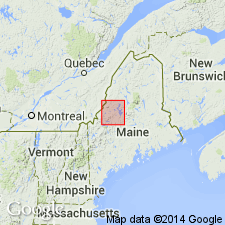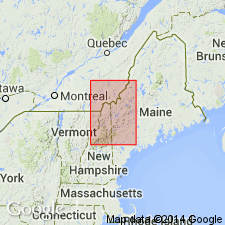
- Usage in publication:
-
- Misery quartzite member*
- Modifications:
-
- Named
- Dominant lithology:
-
- Quartzite
- Sandstone
- Slate
- Siltstone
- AAPG geologic province:
-
- New England province
Summary:
Pg. 167-168, pl. 34. Misery quartzite member of Tarratine formation (new). Occurs in northern Somerset County, Maine. Where present, it divides Tarratine formation into an upper and lower part. Consists of interbedded light-gray, fine- to medium-grained quartzite, dark sandstone, siltstone, and slate which occurs near top of formation. Grades into main part of the Tarratine above and below. Thickness ranges from 4 to 500 feet. Age is Early Devonian (Oriskany). Fossils not found in member but it lies within main part of the Tarratine, which is of Oriskany age. Report includes geologic map and correlation chart.
Type section: at northwest end of railroad cut through Misery Ridge at east end of Tarratine, Brassau Lake 15-min quadrangle, northern Somerset Co., west-central ME. Named from Misery Ridge.
Source: US geologic names lexicon (USGS Bull. 1350, p. 495); GNU records (USGS DDS-6; Reston GNULEX).

- Usage in publication:
-
- Misery Quartzite Member*
- Modifications:
-
- Overview
- AAPG geologic province:
-
- New England province
Summary:
Used as Misery Quartzite Member of Tarratine Formation of Moose River Group in Boundary Mountains-Bronson Hill anticlinorium. Age is Early Devonian.
Source: GNU records (USGS DDS-6; Reston GNULEX).
For more information, please contact Nancy Stamm, Geologic Names Committee Secretary.
Asterisk (*) indicates published by U.S. Geological Survey authors.
"No current usage" (†) implies that a name has been abandoned or has fallen into disuse. Former usage and, if known, replacement name given in parentheses ( ).
Slash (/) indicates name conflicts with nomenclatural guidelines (CSN, 1933; ACSN, 1961, 1970; NACSN, 1983, 2005, 2021). May be explained within brackets ([ ]).

